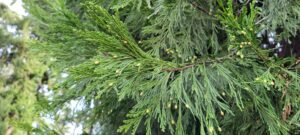Tag: cedar
Eugene’s Winter Trees
Our Favorite Trees to Watch in Winter
Many trees have shed their leaves and are on their way to being dormant for the winter. But not all of them! Late fall and winter in Oregon and Washington is still a wonderful time to admire trees. Our Eugene team put together some of their favorites to watch out for this time of year.
One of the most brilliant fall trees is the gingko, whose intense yellow leaves tend to fall all at once, thanks to their unique stems. Although ginkgos have “broad” leaves, they are actually more closely related to conifers. The modern ginkgo has changed little since its ancestors first graced the planet more than 200 million years ago—tens of millions of years before the advent of conifers and more than a hundred million years before broad-leafed trees became abundant.

For many the Douglas-fir, Oregon’s state tree, is a quintessential evergreen conifer, especially as many of them head into our living rooms for the holidays. Douglas-fir dominates local woodlands, and is joined sometimes by valley ponderosa pine, incense-cedar, and grand fir.
Conifers like the Doug-fir are perfectly adapted to our area’s wet winters and dry summers. Part of what makes Eugene special is that while the urban forest is composed largely of broad-leafed deciduous trees, it’s punctuated with firs, incense-cedars, giant sequoias and other conifers.
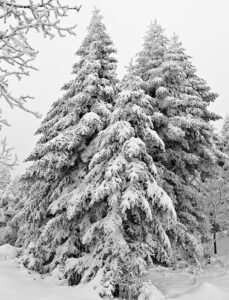
One of the many reasons we love evergreen conifers—they work year-round, producing oxygen and storing up carbon through photosynthesis, and providing important stormwater benefits by intercepting precipitation in their dense canopies.
Another favorite? The Atlas cedar, one of our true cedars. You can tell the cones of true cedars, like the atlas cedar, because they stick up vertically and shed their bracts one by one while staying attached to the tree.
The Atlas cedar notable is this time of year because it’s already releasing its pollen. Many conifers, in particular, “bloom” during late fall and winter. Atlas cedars (Cedrus atlantica) have exceptionally large and showy pollen cones, sometimes two to three inches in length and up to half an inch in diameter. The spent pollen cones are most noticeable after they have fallen, when they carpet the ground beneath the tree with what look like big, fuzzy, yellow caterpillars.
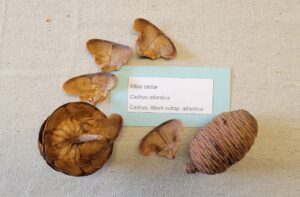
Keep in mind, wind pollinated trees are responsible for allergies, rather than showy flowers. Trees like the incense cedar will be putting out pollen in December. But the rain might save us—heavy rain will knock the particulates out of the air, cleaning them up for us.
Many people have the impression that, during the winter, trees—especially broad-leafed deciduous ones—are completely dormant. But thanks to relatively mild winters in western Oregon, it’s possible to find at least one species of broad-leafed tree—and sometimes several or more—in bloom during any given month of winter. In December, the long, dangling, pollen-bearing catkins of European filberts begin to develop—and the tiny, magenta female flowers do, too, though they’re not nearly as conspicuous. And in January, we begin to see the first elm flowers. Keep your eye out for these lovely signs of life!
Pints & Pinecones in Eugene

The Eugene Branch showed off their epic cone collection at Oakshire Brewing
This month, the Eugene Branch put on a tree trivia—Treevia!—at Oakshire Brewing. The Eugene staff was joined by partners, arborists, volunteers, and supporters to talk trees over a few pints, and a dollar from each beer went back to Friends of Trees. “It was a fitting place because the brewery is in the Whiteaker neighborhood in Eugene, which is famous for tree advocacy,” says Eugene Director Erik Burke.
For the trivia, they focused on cones, the strange and varied structures that are specific to conifer trees. On a table at Oakshire Brewing, FOT laid out an assortment of cones, big and small, prickly and smooth, and asked folks to match them to their corresponding trees.
“We had a great turn out of familiar faces,” says Taylor Glass, the volunteer and program specialist in Eugene. “Showing them all these really cool cones, it’s a fun way to connect.”

It’s not just pine trees that make cones. Cypresses and cedars also produce cones in order to reproduce. Pines, cypresses, and cedars are all conifers—so named for their cones, of course. “Male cones that put out pollen, which has already started,” says Erik. “What we think of as pine cones are the female seed cones.”
The little plates in the cones, called bracts, each contain an individual seed. Some deciduous trees, like our native white alder, also produce male pollen structures called catkins and the female catkins turn into cones that look like pine cones.
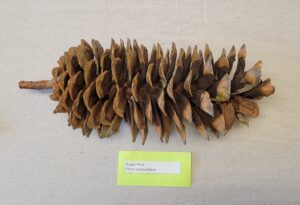
Sugar Pine: Native people ate valley ponderosa pine and sugar pine seeds. In fact, most of the seeds in cones in the pine family are edible (pine nuts)!
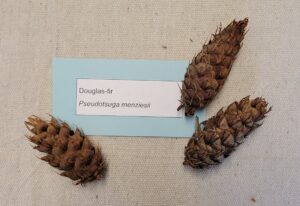
The Douglas-fir is the most common tree in the Pacific Northwest and it’s cone is very recognizable. The story is that a mouse was running along, and a hawk swooped down on it, so it jumped inside the cone, but you can still see its little feet sticking out.
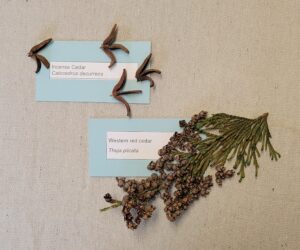
The Oregon native trees that we call natives, incense cedar and western red cedar, are actually in the cypress family. Incense cedars have little cones that look like duck bills, and western red cedar cones look like little roses.

True cedars are in the pine family and come from Africa, Asia and Europe. Not everything we call a cedar is a true cedar. You can tell the cones of true cedars, like the Atlas cedar, because they stick up vertically and shed their bracts one by one while staying attached to the tree.
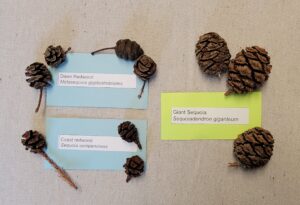
How amazing that redwoods and sequoias, the largest trees in North America, come from these little cones and have tiny seeds.
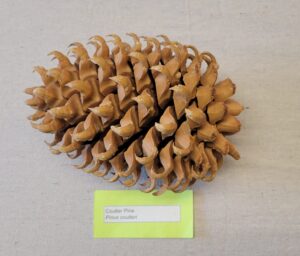
The Coulter pine’s cone is pretty intense! It’s got sharp points, and it’s heavy too, so heads up!
Largest Western Red Cedar in Oregon?

The team at Ascending the Giants is at it again, this time searching for the largest Western Red Cedar in Oregon.
The latest update from their Facebook page reads that they may have found one on the Oregon Coast that boasts a preliminary circumference measurement greater than the current champ.
Friends of Trees plants hundreds of Western Red Cedars every season via both its Neighborhood Trees program (large street and yard trees in neighborhoods) and Green Space Initiative program (small trees in natural areas).

To see the entire photo album, visit Ascending the Giants at their Facebook page.
–Toshio Suzuki
Vancouver talk focuses on tree assessment

By Jesse Batty
On Tuesday, Vancouver Urban Forestry held another TreeTalk workshop, this time on ‘Hazard Tree Risk Assessment.’
Native trees here in the Pacific Northwest, like Bigleaf Maple, Douglas-fir, Western Redcedar and Oregon White Oak, among others, are designed to withstand wind.
Trees that fail and fall are those that have shown some signs of stress and are most often hazard trees. Homeowners can look for signs of stress in their trees by looking for indicators such as decayed wood, mushrooms, cracks, root problems, weak branch unions, cankers and dead limbs.
Gift Trees: A planting to remember
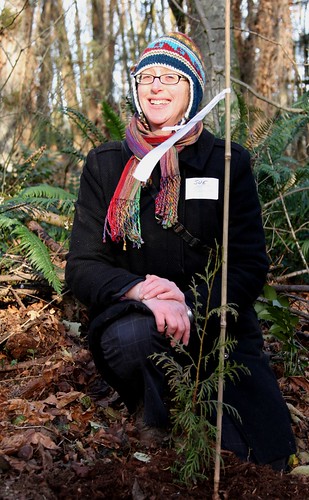
For the first time Sunday, Friends of Trees planted at Collins Sanctuary in Forest Park.
In a celebratory, invite-only planting, volunteers who gave or received Gift Trees came together on a crisp and beautiful December morning to plant trees in honor and memory.
While one goal of the day was to restore the structure and overarching tree canopy, for many planters—a few of whom came from as far as McMinnville—there were very specific, personal reasons for wanting to plant living roots into the soil.
As Sister Pat Nagle said during her short pre-planting benediction: “For in the tree of life, their roots and ours are forever intertwined.”
-To give the gift that keeps growing and see an example of the acknowledgment card please visit our web site. Order your customized card by December 15th to receive it before the holidays.
-Don’t despair if you’re a last-minute shopper like us. This year we also have pre-printed Gift Trees cards available in all seven Backyard Bird Shop locations and at our office.
-The next Gift Trees planting will be March 28, 2010, also at Collins Sanctuary.
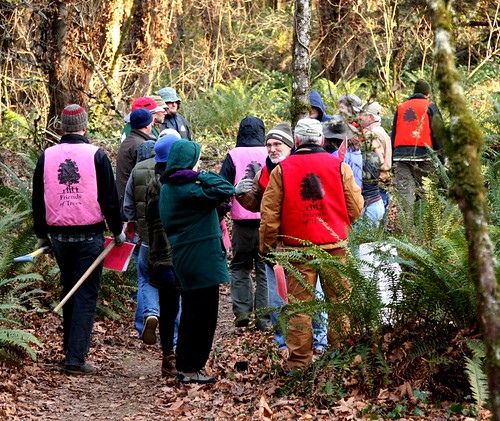
–Melissa Barber and Toshio Suzuki

